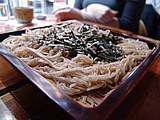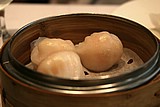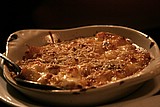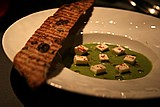Home |
Restaurants by City
|
Food Photography |
Archive | Philosophy |
![]()
Right now we are eating in Seattle, Washington.
|
Monday
2004
Permalink
|
Honmura An, New York, NY, tasted on February 19, 2004 — I hate to generalize, and especially when it sounds so cliché, but there is an aesthetic about Japan. It's actually more of a framework for aesthetics - a value system. Multiple aesthetics spring forth from it. But some of its core tenets include, simplicity, authenticity, beauty, tradition. I know, it sounds cliché, but at the heart of many clichés is a core of truth. And even though I've only been to Japan a few times (and spent my time mostly in Tokyo) these tenets are undeniable - especially when it comes to the food. I won't spend a ton of time talking about the various foods in Japan and my realization some time ago about my own shortsightedness about the diversity of Japanese cuisine. But suffice it to say, Soba cuisine is one of those many points on the Japanese spectrum that remains quite underrepresented in the United States (and I think most of the rest of the world). (With that long preamble over with) walking into Honmura An was like walking into a tiny slice of Tokyo nestled in New York City. I don't worry much about decor or environment, but I have to admit that the comfort I felt walking in there, the familiarity, was nice, settling, exciting. The Avocado Salad that showed up just reinforced the emotional connection I was already having with the restaurant. It contained sliced avocado served with chopped scallion, wasabi, and bonito flakes. The flavors were stark and simple. The bonito flakes contrasted with the avocado. It doesn't get simpler (or more beautiful) than this. The avocado was followed up with Asparagus Salad - Blanched Asparagus with Sesame Seed Dressing. The sauce tasted like thousand island dressing but it was still yummy. Next up was Atsuyaki Tamago - Thick Japanese Omelets Flavored with "Mirin" Japanese Sweet Sake. I read a book once that said you could judge a sushi restaurant in Japan based on the quality of its Tamago. The thinking is that this simple dish will expose your talent or your flaws. Its simplicity leaves nothing to hide flaws behind. The many layers of egg cooked in a square copper pan, all the while manipulated expertly with chopsticks, is definitely a sight to behold. And this particular rendition couldn't have been sweeter, more subtle, or more enjoyably complex. At this point things were moving a long at a perfect pace. It's amazing how much good timing can affect how much you enjoy your meal. Momiji Tataki is Carpaccio Style Japanese Rare Roast Beef and it's also what showed up next at our table. The beef was served with spicy daikon. The flavors were again stark and perfectly complementary. According to the group at the table the dish had "wabi". We also got some Prawn Tempura. Super simple. Peyman thought there was too much shiso, but I thought it was nice. The frying was delicate, deliberate, and balanced. Soba Gaki a Soba Gnocchi Served in a Bamboo Lacquer Ware Box with a Daikon Radish Dipping Sauce. According to the menu it's "very healthy and esoteric". According to us the "gnocchi" was like a Japanese matzah ball. After the waitress broke it up with chopsticks we dipped it in a delicious dashi-based sauce with grated daikon. I loved the sauce and the texture. Even though the food was mesmerizing, it didn't stop us from checking out the guy in the back of the restaurant making soba by hand. Cool! Up next was Kamonan - a hot duck-based soup topped with sliced duck and scallion. The duck broth was gorgeous and oily in a good way. Its flavor was deep but light (does that make any sense? It would if you'd tasted it). We also ordered the Okame "Rosy Cheek" (I love Japanese names). This mix was good as well. And finally it was time for our soba - the specialty of the house. I never thought cold noodles could be so incredible. But never say never. If someone actually took the time to properly edit my postings then they would tell me I'd overused the notion of being surprised at how simple and yet beguilingly delicious each dish was at this meal. Overused or otherwise, it just happens to be the truth. The cold soba noodles were so simple and nutty. Once the sauce and condiments were added, the rich tangy brewed flavor truly came out. Who would have thunk cold noodles could be so delicious? Not me. But then I would have been wrong. Once you'd slurped up all the noodles and a bunch of the sauce you would have thought that the fun would be over as all you have left at this point is left over sauce and some soba water (the water the noodles were cooked in that drained through the bamboo strainer). Wrong again (sorry to be so negative). You take the soba water and pour it into the teacup with the excess sauce, mix it up, and drink it. Crazy! But delicious. It makes a perfect "after-soup". The starchy water perfectly balanced and was brightened by the deep dark flavor of the sauce. With it's protocol of eating every last drop, soba may be one of the world's perfect foods. It's also good in hot and cold weather. In the mood for dessert? No problem. How about some Green Tea Sponge Cake. The cake was like a perfect microcosm of perfect Japanese detail. It was as if it was built molecule by molecule - each perfectly positioned and polished along the way. We also had Soba Dumplings with Red Bean and Bitter Nori on the side. The sweet little soba "meatballs" in the sweet red bean soup was good. The nori was in fact not bitter but a super yummy concentrated chickeny savory saltiness. Alex thought it might be MSG. Food is subjective. I can't deny that this little oasis in the middle of Manhattan brought back so many positive memories of the detail, design, and ultimately the appreciation for flavor, freshness, beauty, and simplicity. But those values weren't hazy memories. They were present in every dish, every bite, every taste at Honmura An. And that's why I loved it. |
|||
Our Sponsors
Free Car Listings – Hot Tubs – Stools – Saunas – Bar Stools - Calendar and Event Schedules - Food Events and Calendars - Wine Events and Calendars - Digital Photography Resources - Software for Advertisers - Jewish Gifts and Judaica - Howard Stern Podcast - ponytailed blogger Jonathan Schwartz

Browse tastingmenu
Home |
Restaurants by City X |
Food Photography |
Archive | Philosophy |
![]()
Free eBooks: All About Apples
| Autumn Omakase
More:
Discussion |
Cool Food T-Shirts |
Ingredients
| Markets |
Recipes
Search |
Blog FAQ |
Other
Blogs
Best of tastingmenu
|
City View
Entry: July 6, 2006 |
Blue Plate
Entry: June 19, 2006 |
L'Atelier de Joël Robuchon
Entry: July 18, 2006 |
Browse by City
Boston | Chicago | Houston | Las Vegas | Los Angeles | Maui | New York | Philadelphia | Portland | San Francisco | Seattle | Toronto | Utah | Vancouver | Washington D.C.
Bangkok | Beijing | Hong Kong | Seoul | Tokyo
Amsterdam | Berlin | Italy | London | Madrid | Paris | Vienna
Browse by Month
2006
2005
2004
2003
2002
2001
Comments, questions, or feedback:
info / at / tastingmenu / dot / com
All pages Copyright (c) 2001-2006 tastingmenu.com
Last modified 01/30/07.




